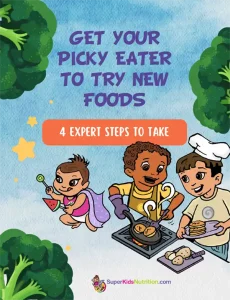
In honor of National Cancer Prevention Month, I asked SuperKids Nutrition founder Melissa Halas, MA, RDN, CDE about many of the important roles that nutrition and physical activity play in cancer prevention.
When it comes to cancer prevention, it’s never too early to start! Parents, here’s what you need to know to help your kids start good habits now!
Why should parents care about the role nutrition plays in cancer prevention? And why focus on kids?
Great strides have been made in educating our nation about nutrition, but there is still much more work to be done. The science of epigenetics (changes to gene expression without changes to the genetic code) shows that what we eat and how much we move during childhood affects how our genes behave. This impacts our risk for many cancers throughout life.
It’s especially important to focus on children to instill long-term habits. Growing evidence suggests that childhood represents a special “window of opportunity” in which everyday choices carry extra importance. During times of rapid growth like childhood and adolescence, our bodies’ cells turn over quickly, making kids particularly sensitive to the effects of diet and activity. A healthy diet and regular exercise can provide protection, but poor diet and inactivity can cause the kind of cellular damage that, over time, may increase the risk for cancer and other diseases later on in life.
Many of the foods kids eat today are disease promoting, not disease preventing. So as a health educator and mom, it’s hard to see children eating an excess of disease promoting foods. If parents knew they could prevent their kids from getting cancer, heart disease, and diabetes later in life by eating a balanced diet full of healthy foods, how powerful could that be for our nation’s future?
Parents often overlook the impact of childhood behaviors on adult disease prevention. Why is that?
I often say it’s common for parents to lather sunscreen on their children for skin cancer prevention, so why should feeding children healthy foods for cancer prevention be any different? Science shows sunscreen protects against skin cancer, just as science shows that a healthy diet and an active lifestyle decreases cancer risk later in life. However, there is often a disconnect – parents can visually see when their child gets sunburned. When they don’t feed their kids health-promoting foods, they can’t see the potential of cancer cells growing and dividing internally as a reminder. Also, the risk isn’t immediate, it’s a long process. Plus, parents have so much on their minds – paying bills, food insecurity, homework, careers, extracurricular activities – and family meal planning may not be high on the list of essential tasks or priorities.
Can you elaborate more on the links between food, physical activity, and cancer risk?
Some of the most compelling evidence to recently emerge revolves around the link between obesity and increased risk for seven different cancers, and today, more kids are overweight and obese than ever before. Over three decades of research from the American Institute for Cancer Research (AICR) has shown that the foods we choose, the amount we move, and the weight we carry directly influence the cancer process. They have pinpointed clear cause-and-effect relationships between 60 specific lifestyle factors and 20 different types of cancer, and continue to identify more.
What roles do physical activity and weight play in cancer risk?
Cancer risk also decreases when people get at least 30 minutes of moderate physical activity every day at any age. Being inactive, however, such as sitting in front of a computer or television many hours each day can increase cancer risk, regardless of a person’s weight.
But when it comes to cancer risk, weight is a major risk factor. Excess body fat causes inflammation, which damages cells and tissues. Over time, this kind of damage makes cancer more likely, according to AICR.
As opposed to focusing on cancer prevention as adults, why should parents start on cancer prevention in their kids?
Although adults tend to be the brunt of cancer outreach efforts, our effort focuses on kids and families because cancer takes years, even decades, to develop. The science of epigenetics is showing that our behaviors can influence how our genes behave throughout life. Those behaviors start young and so must cancer prevention. AICR estimates we could prevent about 1 in 3 cancers in the US every year if we could get kids to start eating smarter, moving more and staying lean throughout their lives. That’s why we started the Healthy Kids Today, Prevent Cancer Tomorrow Campaign at SuperKids Nutrition and AICR.
Can children’s food choices really prevent cancer later in life? What does the data show?
Yes, children’s food choices today can have lasting implications for their future. Here are some alarming statistics:
- Obesity now affects 18.9% of all children and adolescents ages 2-19 years in the United States – triple the rate from just one generation ago. One out of 5 kids is considered obese. (1, 2)
- Obese children are more likely to become obese adults. If children are overweight, obesity in adulthood is likely to be more severe. Adult obesity is associated with a number of serious health conditions including heart disease, diabetes, and some cancers. (2)
- Of the nation’s overweight 5 to 10-year-olds, 61% already exhibit at least one major risk factor for heart disease, and 26% have two or more! One study found that 60% of autopsied accident victims aged 15 to 19 years had atherosclerosis, a precursor to heart disease and the nation’s #1 killer overall.
- 1 in 3 cancers can be prevented through diet, weight and physical activity. Staying lean could prevent more than 116,000 cases of cancer each year in the US alone.
This insight into children’s food choices, physical activity patterns, and weight left us wanting more, so we gathered more from our Q&A to share with you! Head to part 2 of the interview for more tips on how to turn this information into sustainable behaviors that are fun for you and the kids!












